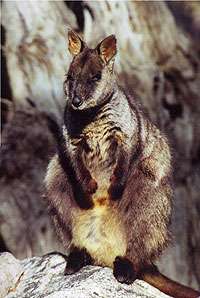Homebodies live on the edge

Scientists have discovered that an endangered Australian rock wallaby loves home so much, it rarely ventures more than a few hundred metres away. The brush-tailed rock wallaby lives in remote pockets of The Great Dividing Range, through Victoria up to Queensland.
University of Queensland PhD student Stephanie Hazlitt, from UQ's School of Integrative Biology, has found that brush-tailed rock wallabies rarely move to other colonies even when neighbours are linked by suitable habitat.
Ms Hazlitt said female brush-tailed rock wallabies moved no more than a few hundred metres away from their homes among the boulders and scrub of the cliff face.
During the study of two wallaby colonies at Killarney and Crows Nest, between Warwick and Toowoomba, female wallabies strayed less than 200 metres and were creating their own families in their mum's backyard.
“It's unexpected for the brush-tailed rock wallaby to show such restricted movement over their lifetime,” Ms Hazlitt said.
“Other rock wallaby species are known to travel up to three kilometres in one day for water.”
The brush-tailed rock wallaby is endangered in New South Wales, critically endangered in Victoria and vulnerable in Queensland.
Ms Hazlitt said her research showed that the best way to conserve the rock wallaby was to protect habitats of current colonies and control feral pests.
“When you're trying to manage this species they're not going anywhere,” she said.
“Unfortunately this means that as soon as you fragment their habitat or introduce predators, you isolate colonies which make them highly susceptible to problems with inbreeding and even local extinction.”
Ms Hazlitt has been studying the brush-tailed rock-wallaby since 2002, when she came to Australia from Canada on an International Post Graduate Research Scholarship.
She has tracked, weighed, observed and recorded a range of vital statistics of the brush-tailed rock wallaby and used radio collars to track them and taken tissue samples to record their DNA and study gene flow.
The 33-year-old from West End is returning to Canada in July to pursue post-doctoral studies.
Her supervisor, UQ Associate Professor Anne Goldizen, started the detailed study of brush-tailed rock wallabies in 2000 which has been added to by her research students along the way.
Ms Hazlitt said it was vital for the brush-tailed rock wallabies to intimately know their environment to avoid predators such as wedge-tailed eagles, foxes and cats.
She said the rock wallabies should be monitored and conserved in Queensland, as they were in fairly healthy numbers compared to New South Wales and Victoria.
Source: University of Queensland















